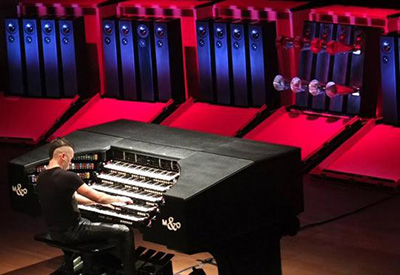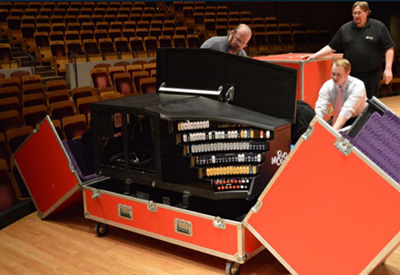Avant-Garde Musician Pulls Out Stops in Digital Concert

What better place to perform selections from Star Wars on a giant futuristic digital organ than North Carolina’s leading high-tech campus? It’s a match made in heaven, or actually in NC State’s newly renovated Stewart Theatre, on Saturday, March 19, when musical provocateur Cameron Carpenter powers up his revolutionary International Touring Organ.
The ITO, as the machine is known, promises “the ultimate acoustical experience for the listener,” incorporating digitized sounds sampled from pipe organs and other instruments across the globe.

Cameron will showcase the breadth of the ITO by performing such touchstones as Barber’s Adagio for Strings and Ravel’s La Valse, as well as selections from Star Wars, An American in Paris, and the song catalogue of Michael Jackson. He will also perform music from his brand new all-Bach recording, scheduled for release in June on Sony Classical.
For more information about this performance, visit live.arts.ncsu.edu.
NC State is part of Cameron’s most ambitious tour to date and the largest tour ever by an organist. He also has roots in the area, studying at the University of North Carolina School of the Arts in Winston-Salem.
Uncharted Soundscapes
Cameron has been praised as “extravagantly talented” by The New York Times. The Los Angeles Times raves, “Carpenter is one of the rare musicians who changes the game of his instrument. He is a smasher of cultural and classical music taboos.”

A daring musical innovator, Cameron introduced his custom-built ITO to the world with a daylong festival at Lincoln Center’s Alice Tully Hall in March 2014. A first of its kind, the instrument allows Cameron to explore uncharted soundscapes and new sonic possibilities for the organ. The ITO is a monumental cross-genre digital organ built by Marshall & Ogletree to Cameron’s own design.
Carpenter smashes stereotypes of organists and organ music, generating international acclaim and controversy unprecedented in his field. His repertoire—from the complete works of Bach to film scores, his original compositions and hundreds of transcriptions and arrangements—is regarded as the largest and most diverse of any organist. He is the first concert organist in history to prefer the digital organ to the pipe organ, and to champion it as the future of the instrument.
Cameron’s latest album and Sony Music debut, If You Could Read My Mind, entered Billboard’s Traditional Classical chart at No. 1 on its U.S. release.

A former child prodigy, Cameron trained at the American Boychoir School, the North Carolina School of the Arts and has two degrees from The Juilliard School. He holds the 2012 Leonard Bernstein Award, is the first solo organist ever nominated for a Grammy for a solo album, and has appeared with many of the world’s great orchestras.
The ITO is the eighth organ by Marshall & Ogletree, the Needham, Massachusetts organ builders redefining the digital organ as an instrument of artistic significance. Its concept is simple: innovate the relationship between organ and organist. While the uniqueness of each pipe organ is part of its collective magic, this makes it impossible to perform the same music regardless of where the organist plays.
The entire organ assembles in less than three hours and travels in a single large truck. Its sound system is a massive complex of specially sourced sound support and amplification equipment housed in mobile, location-adaptable touring cases. The organ console is assembled manually and hydraulically from only six modular parts.
- Categories:


